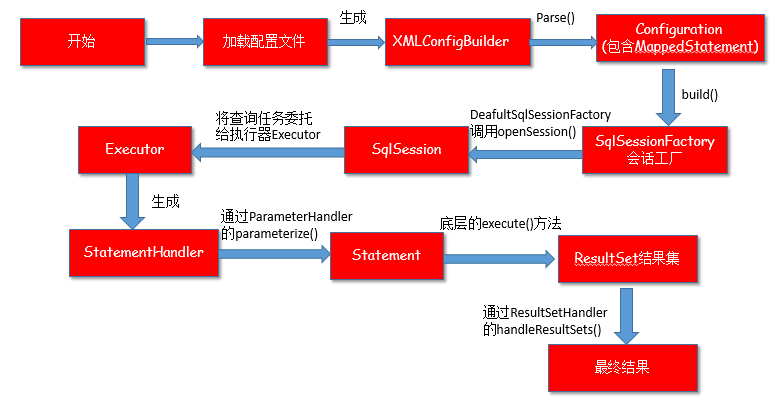MyBatis 的工作原理,你了解过吗?

来源:cnblogs.com/scuury/p/10371246.html
第一步:创建一个sqlSessionFactory 第二步:创建sqlSession 第三步:执行具体的sql请求 总结 参考
近来想写一个mybatis的分页插件,但是在写插件之前肯定要了解一下mybatis具体的工作原理吧,于是边参考别人的博客,边看源码就开干了。
核心部件:
SqlSession Executor StatementHandler ParameterHandler ResultSetHandler TypeHandler MappedStatement Configuration
在分析工作原理之前,首先看一下我的mybatis全局配置文件
"1.0" encoding="UTF-8" ?>
PUBLIC "-//mybatis.org//DTD Config 3.0//EN"
"http://mybatis.org/dtd/mybatis-3-config.dtd">
default="development">
"development">
"JDBC" />
"POOLED">
"driver" value="com.mysql.jdbc.Driver" />
"url"
value="jdbc:mysql://localhost:3306/test?characterEncoding=utf-8" />
"username" value="root" />
"password" value="123456" />
"sqlMapper/userMapper.xml"/>
第一步:创建一个sqlSessionFactory
在了解如何创建sqlSessionFactory之前,先看一下mybatis是如何加载全局配置文件,解析xml文件生成Configuration的
public Configuration parse() {
if (parsed) {
throw new BuilderException("Each XMLConfigBuilder can only be used once.");
}
parsed = true;
parseConfiguration(parser.evalNode("/configuration"));
return configuration;
}
private void parseConfiguration(XNode root) {
try {
propertiesElement(root.evalNode("properties")); //issue #117 read properties first
typeAliasesElement(root.evalNode("typeAliases"));
pluginElement(root.evalNode("plugins"));
objectFactoryElement(root.evalNode("objectFactory"));
objectWrapperFactoryElement(root.evalNode("objectWrapperFactory"));
settingsElement(root.evalNode("settings"));
environmentsElement(root.evalNode("environments")); // read it after objectFactory and objectWrapperFactory issue #631
databaseIdProviderElement(root.evalNode("databaseIdProvider"));
typeHandlerElement(root.evalNode("typeHandlers"));
mapperElement(root.evalNode("mappers"));
} catch (Exception e) {
throw new BuilderException("Error parsing SQL Mapper Configuration. Cause: " + e, e);
}
}
在上面的第二段代码中有一句
mapperElement(root.evalNode("mappers"));
刚好我们的全局配置文件中有一个mapper的配置,由此可见,mapperElemet()方法是解析mapper映射文件的,具体代码如下
private void mapperElement(XNode parent) throws Exception {
if (parent != null) {
for (XNode child : parent.getChildren()) {
if ("package".equals(child.getName())) {
String mapperPackage = child.getStringAttribute("name");
configuration.addMappers(mapperPackage);
} else {
String resource = child.getStringAttribute("resource");
String url = child.getStringAttribute("url");
String mapperClass = child.getStringAttribute("class");
if (resource != null && url == null && mapperClass == null) {//进入该判断
ErrorContext.instance().resource(resource);
InputStream inputStream = Resources.getResourceAsStream(resource);
XMLMapperBuilder mapperParser = new XMLMapperBuilder(inputStream, configuration, resource, configuration.getSqlFragments());
mapperParser.parse();
} else if (resource == null && url != null && mapperClass == null) {
ErrorContext.instance().resource(url);
InputStream inputStream = Resources.getUrlAsStream(url);
XMLMapperBuilder mapperParser = new XMLMapperBuilder(inputStream, configuration, url, configuration.getSqlFragments());
mapperParser.parse();
} else if (resource == null && url == null && mapperClass != null) {
Class mapperInterface = Resources.classForName(mapperClass);
configuration.addMapper(mapperInterface);
} else {
throw new BuilderException("A mapper element may only specify a url, resource or class, but not more than one.");
}
}
}
}
}
根据以上代码可以分析,在写mapper映射文件的地址时不仅可以写成resource,还可以写成url和mapperClass的形式,由于我们用的是resource,所以直接进入第一个判断,最后解析mapper映射文件的方法是
private void configurationElement(XNode context) {
try {
String namespace = context.getStringAttribute("namespace");
if (namespace.equals("")) {
throw new BuilderException("Mapper's namespace cannot be empty");
}
builderAssistant.setCurrentNamespace(namespace);
cacheRefElement(context.evalNode("cache-ref"));
cacheElement(context.evalNode("cache"));
parameterMapElement(context.evalNodes("/mapper/parameterMap"));
resultMapElements(context.evalNodes("/mapper/resultMap"));
sqlElement(context.evalNodes("/mapper/sql"));
buildStatementFromContext(context.evalNodes("select|insert|update|delete"));
} catch (Exception e) {
throw new BuilderException("Error parsing Mapper XML. Cause: " + e, e);
}
}
其中具体解析每一个sql语句节点的是
buildStatementFromContext(context.evalNodes("select|insert|update|delete"));
进入这个方法一层层深究,最后到这里可以知道MappedStatement是由builderAssistant(即MapperBuildAssistant)创建的。
public void parseStatementNode() {
...
builderAssistant.addMappedStatement(id, sqlSource, statementType, sqlCommandType,
fetchSize, timeout, parameterMap, parameterTypeClass, resultMap, resultTypeClass,
resultSetTypeEnum, flushCache, useCache, resultOrdered,
keyGenerator, keyProperty, keyColumn, databaseId, langDriver, resultSets);
}
最后进入方法addMappedStatement(),mappedStatement最后以id为键保存在了Configuration中的一个map变量mappedStatements中。
public MappedStatement addMappedStatement(
String id,
SqlSource sqlSource,
StatementType statementType,
SqlCommandType sqlCommandType,
Integer fetchSize,
Integer timeout,
String parameterMap,
Class parameterType,
String resultMap,
Class resultType,
ResultSetType resultSetType,
boolean flushCache,
boolean useCache,
boolean resultOrdered,
KeyGenerator keyGenerator,
String keyProperty,
String keyColumn,
String databaseId,
LanguageDriver lang,
String resultSets) {
if (unresolvedCacheRef) throw new IncompleteElementException("Cache-ref not yet resolved");
id = applyCurrentNamespace(id, false);
boolean isSelect = sqlCommandType == SqlCommandType.SELECT;
MappedStatement.Builder statementBuilder = new MappedStatement.Builder(configuration, id, sqlSource, sqlCommandType);
statementBuilder.resource(resource);
statementBuilder.fetchSize(fetchSize);
statementBuilder.statementType(statementType);
statementBuilder.keyGenerator(keyGenerator);
statementBuilder.keyProperty(keyProperty);
statementBuilder.keyColumn(keyColumn);
statementBuilder.databaseId(databaseId);
statementBuilder.lang(lang);
statementBuilder.resultOrdered(resultOrdered);
statementBuilder.resulSets(resultSets);
setStatementTimeout(timeout, statementBuilder);
setStatementParameterMap(parameterMap, parameterType, statementBuilder);
setStatementResultMap(resultMap, resultType, resultSetType, statementBuilder);
setStatementCache(isSelect, flushCache, useCache, currentCache, statementBuilder);
MappedStatement statement = statementBuilder.build();
configuration.addMappedStatement(statement);
return statement;
}
最后回到我们的创建sqlSessionFactory上,之前的一切都是为了生成一个sqlSessionFactory服务的
public SqlSessionFactory build(InputStream inputStream, String environment, Properties properties) {
try {
XMLConfigBuilder parser = new XMLConfigBuilder(inputStream, environment, properties);
return build(parser.parse());
} catch (Exception e) {
throw ExceptionFactory.wrapException("Error building SqlSession.", e);
} finally {
ErrorContext.instance().reset();
try {
inputStream.close();
} catch (IOException e) {
// Intentionally ignore. Prefer previous error.
}
}
}
public SqlSessionFactory build(Configuration config) {
return new DefaultSqlSessionFactory(config);
}
从上面的代码可以看出最后是通过以Configuration为参数build()方法生成DefautSqlSessionFactory。
第二步:创建sqlSession
public SqlSession openSession() {
return openSessionFromDataSource(configuration.getDefaultExecutorType(), null, false);
}
private SqlSession openSessionFromDataSource(ExecutorType execType, TransactionIsolationLevel level, boolean autoCommit) {
Transaction tx = null;
try {
final Environment environment = configuration.getEnvironment();
final TransactionFactory transactionFactory = getTransactionFactoryFromEnvironment(environment);
tx = transactionFactory.newTransaction(environment.getDataSource(), level, autoCommit);
final Executor executor = configuration.newExecutor(tx, execType);
return new DefaultSqlSession(configuration, executor, autoCommit);
} catch (Exception e) {
closeTransaction(tx); // may have fetched a connection so lets call close()
throw ExceptionFactory.wrapException("Error opening session. Cause: " + e, e);
} finally {
ErrorContext.instance().reset();
}
}
//返回一个SqlSession,默认使用DefaultSqlSession
public DefaultSqlSession(Configuration configuration, Executor executor, boolean autoCommit) {
this.configuration = configuration;
this.executor = executor;
this.dirty = false;
this.autoCommit = autoCommit;
}
executor在这一步得到创建,具体的使用在下一步。
第三步:执行具体的sql请求
在我的代码里执行的是
User user = sqlSession.selectOne("test.findUserById", 1);
具体到里面的方法就是
public List selectList(String statement, Object parameter, RowBounds rowBounds) {
try {
//1.根据Statement Id,在mybatis 配置对象Configuration中查找和配置文件相对应的MappedStatement
MappedStatement ms = configuration.getMappedStatement(statement);
//2. 将查询任务委托给MyBatis 的执行器 Executor
List result = executor.query(ms, wrapCollection(parameter), rowBounds, Executor.NO_RESULT_HANDLER);
return result;
} catch (Exception e) {
throw ExceptionFactory.wrapException("Error querying database. Cause: " + e, e);
} finally {
ErrorContext.instance().reset();
}
}
在这里通过statementId拿到了我们在第一步存在map里面的MappedStatement。在这里引用参考博客的一句话:
SqlSession根据Statement ID, 在mybatis配置对象Configuration中获取到对应的MappedStatement对象,然后调用mybatis执行器来执行具体的操作。
再继续看query()和queryFromDatabase()这两个方法
@SuppressWarnings("unchecked")
public List query(MappedStatement ms, Object parameter, RowBounds rowBounds, ResultHandler resultHandler, CacheKey key, BoundSql boundSql) throws SQLException {
ErrorContext.instance().resource(ms.getResource()).activity("executing a query").object(ms.getId());
if (closed) throw new ExecutorException("Executor was closed.");
if (queryStack == 0 && ms.isFlushCacheRequired()) {
clearLocalCache();
}
List list;
try {
queryStack++;
list = resultHandler == null ? (List) localCache.getObject(key) : null;
if (list != null) {
handleLocallyCachedOutputParameters(ms, key, parameter, boundSql);
} else {
list = queryFromDatabase(ms, parameter, rowBounds, resultHandler, key, boundSql);
}
} finally {
queryStack--;
}
if (queryStack == 0) {
for (DeferredLoad deferredLoad : deferredLoads) {
deferredLoad.load();
}
deferredLoads.clear(); // issue #601
if (configuration.getLocalCacheScope() == LocalCacheScope.STATEMENT) {
clearLocalCache(); // issue #482
}
}
return list;
}
private List queryFromDatabase(MappedStatement ms, Object parameter, RowBounds rowBounds, ResultHandler resultHandler, CacheKey key, BoundSql boundSql) throws SQLException {
List list;
localCache.putObject(key, EXECUTION_PLACEHOLDER);
try {
list = doQuery(ms, parameter, rowBounds, resultHandler, boundSql);
} finally {
localCache.removeObject(key);
}
localCache.putObject(key, list);
if (ms.getStatementType() == StatementType.CALLABLE) {
localOutputParameterCache.putObject(key, parameter);
}
return list;
}
在这两个方法里面会为当前的查询创建一个缓存key,如果缓存中没有值,直接从数据库中读取,执行查询后将得到的list结果放入缓存之中。
紧接着看doQuery()在SimpleExecutor类中重写的方法
public List doQuery(MappedStatement ms, Object parameter, RowBounds rowBounds, ResultHandler resultHandler, BoundSql boundSql) throws SQLException {
Statement stmt = null;
try {
Configuration configuration = ms.getConfiguration();
StatementHandler handler = configuration.newStatementHandler(wrapper, ms, parameter, rowBounds, resultHandler, boundSql);
stmt = prepareStatement(handler, ms.getStatementLog());
return handler.query(stmt, resultHandler);
} finally {
closeStatement(stmt);
}
}
Statement连接对象就是在这里创建的,因此Executor的作用之一就是创建Statement了,创建完后又把Statement丢给StatementHandler返回List查询结果。
接下来再看一下这里的两个方法prepareStatement()和query()的具体实现
private Statement prepareStatement(StatementHandler handler, Log statementLog) throws SQLException {
Statement stmt;
Connection connection = getConnection(statementLog);
stmt = handler.prepare(connection);
handler.parameterize(stmt);
return stmt;
}
public List query(Statement statement, ResultHandler resultHandler) throws SQLException {
PreparedStatement ps = (PreparedStatement) statement;
ps.execute();
return resultSetHandler. handleResultSets(ps);
}
prepareStatement()是创建Statement的具体实现方法,调用parameterize()对创建的Statement对象设置参数,即为我们设为占位符的地方赋上指定的参数,parameterize()方法再深入进去就是调用ParameterHandler的setParameters()方法具体赋值了。
这里的query()是调用了ResultSetHandler的handleResultSets(Statement) 方法。作用就是把ResultSet结果集对象转换成List类型的集合。
总结以上步骤就是:
根据具体传入的参数,动态地生成需要执行的SQL语句,用BoundSql对象表示 为当前的查询创建一个缓存Key 缓存中没有值,直接从数据库中读取数据 执行查询,返回List 结果,然后 将查询的结果放入缓存之中 根据既有的参数,创建StatementHandler对象来执行查询操作 将创建Statement传递给StatementHandler对象,调用parameterize()方法赋值 调用StatementHandler.query()方法,返回List结果集
总结
以上三个步骤所有流程大体可以用一张图来总结

(END)
更多精彩: 有了这款可视化工具,Java 应用性能调优超简单! 10k+点赞的 SpringBoot 后台管理系统竟然出了详细教程! 程序员 1024 刷屏漫画,非常有趣! 求求你别再用System.out.println 了,有更好的选择! 使用IntelliJ IDEA查看类图,内容极度舒适 关注公众号,查看更多优质文章 最近,整理一份Java资料《Java从0到1》,覆盖了Java核心技术、JVM、Java并发、SSM、微服务、数据库、数据结构等等。 获取方式:关注公众号并回复 Java 领取,更多Java内容陆续奉上。 明天见(。・ω・。)ノ♡
